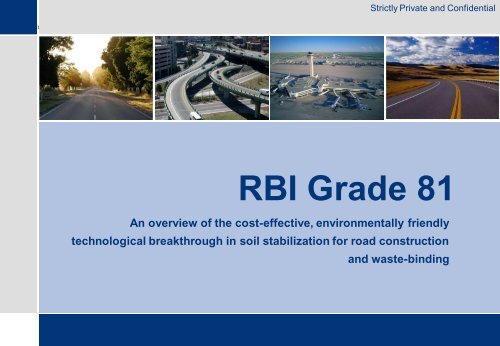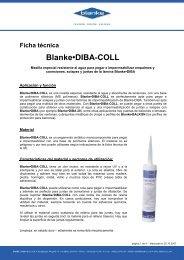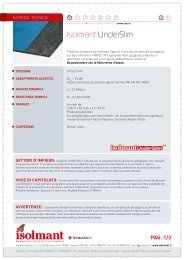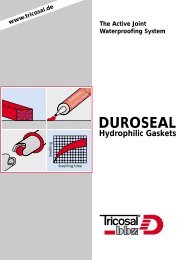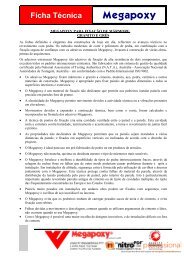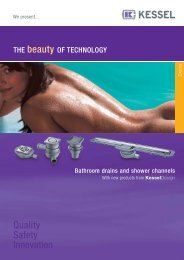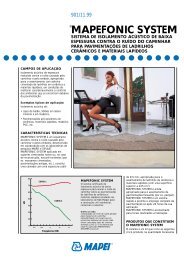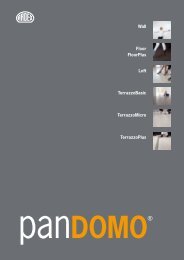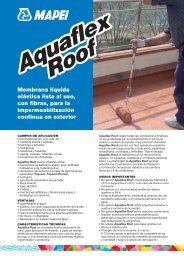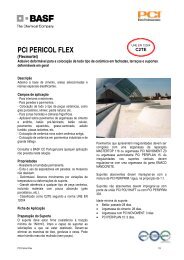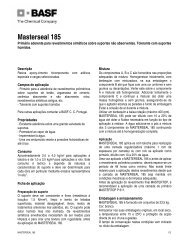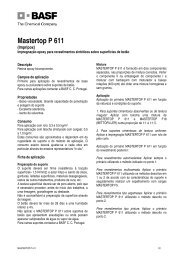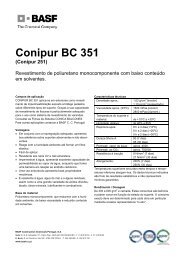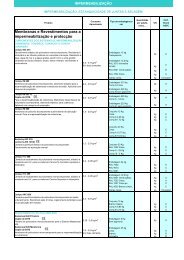RBI Grade 81
RBI Grade 81
RBI Grade 81
- No tags were found...
Create successful ePaper yourself
Turn your PDF publications into a flip-book with our unique Google optimized e-Paper software.
Table of contents2SECTIONSPage1. Introduction 32. Brief history of <strong>RBI</strong> (Marketing) Netherlands B.V. 63. Superiority of <strong>RBI</strong> <strong>Grade</strong> <strong>81</strong> 94. Benefits of <strong>RBI</strong> <strong>Grade</strong> <strong>81</strong> – Financial benefits 125. Benefits of <strong>RBI</strong> <strong>Grade</strong> <strong>81</strong> – Environmental benefits 146. Application methodology 167. Select case studies 188. Conclusion 27
3Section 1:Introduction
Introduction: <strong>RBI</strong> <strong>Grade</strong> <strong>81</strong>New and improved technology in the field of road construction4Delivers an economicand cost effectivesolution capable ofproviding rapidinfrastructuredevelopment ……avoiding theenvironmental burdensassociated withconventional roadconstruction• An advanced, cost effective and environmentally beneficial technological breakthrough in soil stabilisation• An inorganic chemical stabiliser that modifies the engineering properties of soil• Development of the technology was internationally coordinated by Road Building International since 1990• The aim was to develop a soil stabiliser that could be effectively used in the construction of roads using both in-situ, recycledand waste materials, offering the following:— Environmental benefits: Avoids the depletion of natural resources— Cost efficiency: Savings of up to 50% of the costs of conventional road construction— Irreversibility: No maintenance required during the life of road— Applications: Applicable under all temperature conditions and soil types• Overcome the challenges and shortcomings of conventional road construction and soil stabilisation• This presentation sets out:— Brief history of <strong>RBI</strong> <strong>Grade</strong> <strong>81</strong>— The challenge of conventional road construction and the solution in <strong>RBI</strong> <strong>Grade</strong> <strong>81</strong>— Benefits offered by the technology
Indian application (2008) – unskilled female labour was used to construct durable,impermeable road using <strong>RBI</strong> <strong>Grade</strong> <strong>81</strong>• In-situ soil material typically does not meet standards required for road construction— Typical removal requirement of 1,400 x 30 ton truck loads per km of road when using conventional methods— Soil material transported to dumping area— Replaced with new soil obtained from commercial site all at significant cost• Results in inefficient use of construction equipment which remains idle during this process, and significant traffic disruption• In the Indian application shown below:— 3 x 30 ton truck loads of <strong>RBI</strong> <strong>Grade</strong> <strong>81</strong> was used to stabilise a mountain pass road— vehicular traffic of several hundred vehicles per hour— Unskilled female labor was used from surrounding communities• As compaction was completed, the road was opened to traffic immediately –traffic was never fully stopped during the application51 2 3After road surface compaction, the road surface was immediately opened to traffic4 5 6Final road surface
6Section 2:Brief history of the company
History of <strong>RBI</strong> <strong>Grade</strong> <strong>81</strong>7TimelineCompany history<strong>RBI</strong> <strong>Grade</strong> <strong>81</strong> a proven andtested technology,internationally patented…1990-2000 • <strong>RBI</strong> <strong>Grade</strong> <strong>81</strong> goes through research and development, irreversibility and durability tests, and tests for performance-over-time2000-2004 • Holding company <strong>RBI</strong> Marketing (Netherlands) B.V. formalised and launches international patent on every continent• Patent applications went completely uncontested and approved as a ―unique and novel concept‖2003-2004 • <strong>RBI</strong> Marketing (Netherlands) B.V. sells its patent rights to the technology in America, Africa, Australia to Anyway Solutions(www.anywaysolutions.com), who achieved a number of key accolades in a very short space of time, including— The approval of the product to the United Nations Development Program (―UNDP‖)— Approval of product by International Labour Organisation (―ILO‖)— The Prix D’Excellence award in Africa (2007)2005-2006 • <strong>RBI</strong> Marketing (Netherlands) B.V licenses Readers in the United Kingdom, a division of Langley Holding PLC, a multinational engineeringgroup, rated by HSBC as one of the UK’s top 250 company’s, to produce <strong>RBI</strong> <strong>Grade</strong> <strong>81</strong>• European Investment Bank confirms co-operation for future implementation of <strong>RBI</strong> in infrastructure and environmental projects2004-2010 • On-going certification and research includes, amongst others:— Pavement Technology, Harriot Watt University:“…the <strong>RBI</strong> <strong>Grade</strong> <strong>81</strong> stabilized layer can perform as a foundation layer for any layerof the road within Western Europe...”— Ministry of Transport in Portugal:“...incorporate <strong>RBI</strong> <strong>Grade</strong> <strong>81</strong> in terms of road specifications for Portugal…”— Dorservice Institute, St Petersbourg:“…GOST standards approval on all pavement layers and under severe permafrostconditions…”— South Africa, CSRI / SA Bureau of Standards:“…<strong>RBI</strong> <strong>Grade</strong> <strong>81</strong> specified for incorporation into road design…”…gaining wide-spreadacclaim in India with thespecification ingovernment roadconstruction tenders— Polytechnic university of Bari, Italy:”…approved for use in Italian road design…”— Virginia Polytechnic Institute, USA:“…<strong>RBI</strong> <strong>Grade</strong> <strong>81</strong> was more effective in increasing the strength of soils tested…”2008-2010 • <strong>RBI</strong> targets India as the Asian market entry point, given the regional potential and scope for use— Government 5 year budget of US$1 trillion for repair of existing infrastructure and new road construction— The technology is currently being manufactured under ISO: 9001— Repeatedly utilised by the Indian army— 1 st specification in government tender of Andhra Pradesh (2009)
Anyway Solutions: Distributor of <strong>RBI</strong> <strong>Grade</strong> <strong>81</strong> in AfricaProperty developments in Africa using <strong>RBI</strong> <strong>Grade</strong> <strong>81</strong>8• Anyway Solutions significant impact in the African road and property market• Projects in the space of low cost housing, brick making and general infrastructure development<strong>RBI</strong> <strong>Grade</strong> <strong>81</strong> used inMadagascar developmentat the presidential LaVitrine...• Compressed stabilized earth block (―CSEB‖) production• Mandated by the president of Madagascar in his presidential La Vitrine• CSEB’s manufactured using only manually-powered machinery• Justice Ministry of Madagascar requested funding to build 3 prison camps with <strong>RBI</strong> <strong>Grade</strong> <strong>81</strong>...build low cost housingin South Africa as part ofthe South African RuralCommunity DevelopmentPlan (“RCDP”)• <strong>RBI</strong> <strong>Grade</strong> <strong>81</strong> used in the Rural Community Development Plan (―RCDP‖) in South Africa• Collaboration with the Gauteng Economic Development Agency (―GEDA‖)• All activities were done with the active participation of the local community• Beneficiaries included the community of Simunye, located in Gauteng• Project involved brick manufacture, house construction and road construction to community...stabilised in-situ soil forthe construction of the2010 FIFA World cupstadium in Durban• FIFA World Cup 2010, South Africa• In-situ soil could not support stadium load and construction equipment• <strong>RBI</strong> <strong>Grade</strong> <strong>81</strong> used to stabilise in-situ soil materials facilitating construction of stadium• Designed to carry extreme loads indefinitely
9Section 3:Superiority of <strong>RBI</strong> <strong>Grade</strong> <strong>81</strong>
<strong>RBI</strong> <strong>Grade</strong> <strong>81</strong>: Next generation of soil stabilisation technologyOffers benefits over all methods of road construction which are limited in their fields of use10Applicable on all soiltypes, avoiding theotherwise necessaryexchange of soilcommonly associated withconventional roadconstruction• Conventional products are limited in applicability, highly expensive and costly• <strong>RBI</strong> <strong>Grade</strong> <strong>81</strong> can be successfully applied to all soil typesCement Lime Bitumen <strong>RBI</strong> <strong>Grade</strong> <strong>81</strong>Used in the following soil Types Fine clay (
<strong>RBI</strong> <strong>Grade</strong> <strong>81</strong>: Superior performance on all measures11Significantly enhancedstrength gains using <strong>RBI</strong><strong>Grade</strong> <strong>81</strong>…• <strong>RBI</strong> <strong>Grade</strong> <strong>81</strong> superior to conventional methods— Strength: Performance under traffic— Temperature: Temperature and moisture impact— Durability: Resistance to cracking and deformationStrength effectiveness• <strong>RBI</strong> <strong>Grade</strong> <strong>81</strong> improves the engineering properties of soil— Bearing capacity (CBR)— Compressive strength (UCS)— Plasticity and elastic modulus (stiffness)— Frost resistance, impermeability and sensitivity tomoisture1―…Superior strength gainsachieved by using <strong>RBI</strong> <strong>Grade</strong><strong>81</strong>…‖Temperature effectivenessDurability over time…offering versatilityacross temperatureranges…FlexiblepavementProne to deformation due toexcessive loading over time4…with considerablelongevity and durabilityincreases2 3Temperaturezone 1:• Strength lossdue to frostactionTemperature zone 2:• Strength loss dueto evaporation ofmoistureSemi rigidpavementRigidpavementNon flexible pavement prone tocracking and deformationIdeal pavement structureLime Bitumen Cement <strong>RBI</strong>56
12Section 4:Benefits of <strong>RBI</strong> <strong>Grade</strong> <strong>81</strong> – Financial benefits
Cost efficacy of <strong>RBI</strong> <strong>Grade</strong> <strong>81</strong>: Savings of up to 50%13• The economic savings attributable to the use of <strong>RBI</strong> <strong>Grade</strong> <strong>81</strong> are in the following categories:1— The ability of <strong>RBI</strong> <strong>Grade</strong> <strong>81</strong> to stabilise all in-situ soils avoiding the otherwise necessary replacement of in-situ material— Saving on labour costs, contractor cost, engineering cost, equipment costs and raw material costs23— The increased productivity of the construction site, projects completed well ahead of schedule— Complete elimination of on-going maintenance costs under all weather conditions45— A reduction in vehicle damagesResults: Bangalore-Hoskote-Mulbagal section, National Highway 4 in state of Karnataka under NHDP Phase III AThe use of <strong>RBI</strong> <strong>Grade</strong> <strong>81</strong>reduces the collectiveassociated costs of roadconstruction by up to50% when compared tothe equivalent projectscompleted usingconventional methods,taking into account thesavings in:• raw and aggregatematerial costs• construction costs• time to construction• maintenance costsArea of cost saving Achievement Savings• Saving in construction time:— Conventional method time requirement for 1 km length:30 days50.0%— <strong>RBI</strong> <strong>Grade</strong> <strong>81</strong> time requirement for 1 km length:15 days• Saving in aggregate material:― Aggregate required by conventional method for 1 sqm area:0.4 cum85.0%― Aggregate required by <strong>RBI</strong> <strong>Grade</strong> <strong>81</strong> for 1 sqm area:0.06 cum• Saving in truck trips (40 ton trucks)— Trips required for 1000 sqm in conventional method:320 trips 84.3%— Trips required for 1000 sqm using <strong>RBI</strong> <strong>Grade</strong> <strong>81</strong>:50 trips• Direct cost saving in construction cost― Cost per sqm using conventional methods:Rs1001.41 15.6%― Cost per sqm using <strong>RBI</strong> <strong>Grade</strong> <strong>81</strong>:Rs 845.00• Saving in maintenance— There is no maintenance cost to a road built using <strong>RBI</strong> <strong>Grade</strong> <strong>81</strong>100%
14Section 5:Benefits of <strong>RBI</strong> <strong>Grade</strong> <strong>81</strong> – Environmental benefits
Benefits of the technology: Environmental burden reduction15Environmental benefits attributable to the use of <strong>RBI</strong> <strong>Grade</strong> <strong>81</strong><strong>RBI</strong> <strong>Grade</strong> <strong>81</strong>, in addition toreducing the depletion ofnatural resources, offerssignificant environmentalbenefits over conventionalstabilisation methods....• The environmental and social benefits of using <strong>RBI</strong> <strong>Grade</strong> <strong>81</strong> are significant• <strong>RBI</strong> <strong>Grade</strong> <strong>81</strong> is certified under BS EN ISO 9001:2000ConstructionstagePre-constructionphaseSpecific saving• <strong>RBI</strong> <strong>Grade</strong> <strong>81</strong> facilitates the use of in-situ soil material, avoiding the conventional need for sourcing quarrymaterials• Reduction in raw material requirements in terms of stabilisation materials, fuel, labour and construction time• No requirement for prospecting and the creation of new borrow-pits• Reduction in requirement for non-renewables in energy consumption and soil materials• Minimisation of energy consumption in the construction phaseConstructionphase• Waste materials from steel works and coal fired power plants a component of <strong>RBI</strong> <strong>Grade</strong> <strong>81</strong>• Complete elimination of waste dumping to landfill, <strong>RBI</strong> <strong>Grade</strong> <strong>81</strong> facilitates the use of recycled soil material...creating employment andgeneral communityupliftment opportunities tosurrounding communitiesUse of road• Significant carbon offset in savings achieved during road construction phase• Allows for the recycling of asphalt, stabilising the sub-layer of soil• Eliminates leaching of bitumen and harmful chemicals due to integrity of sub-layer treated with <strong>RBI</strong> <strong>Grade</strong> <strong>81</strong>• Prevention of soil erosion• Minimisation of dustiness of gravel roads avoiding the contamination of vegetation of crops
16Section 6:Application methodology
Application methodology: A 5 step processDescription of methodologyMethodology17Application of <strong>RBI</strong> <strong>Grade</strong> <strong>81</strong>is a simple 5-stage process...1Stage 1: Scarifying• Creation of a homogeneous layer... with the simple addition ofwater as an activator, <strong>RBI</strong><strong>Grade</strong> <strong>81</strong> acts to stabilise insitumaterial creating animpermeable layer, resistantunder all weather conditions23Stage 2: Application• Application of <strong>RBI</strong> <strong>Grade</strong> <strong>81</strong> powder at apre-determined dosageStage 3: Activation• Application of water to moisten materialand activate <strong>RBI</strong> <strong>Grade</strong> <strong>81</strong> chemicalreactionRainfall has been found toincrease bearing strengthimproving the quality anddurability of the roadsurface...4Stage 4: Mixing• Mixing of the moisten material and <strong>RBI</strong><strong>Grade</strong> <strong>81</strong> in preparation for compaction...road can be opened totraffic almost immediately5Stage 5: Shaping and compaction• Shaping the road to final level and camberand final compaction
18Section 7:Select case studies
Indian runway (2009) – “…ground breaking runway construction…”Milestone achievement19• Runway built in Himalaya mountains• Significant strategic military importance• Quoted as ―...groundbreaking...‖ in local newspapers— 2.75 km runway, 45 m width, Stabilised to a depth of 0.25m— 37,500 square meters stabilised— Stabilised at an altitude of 16,000 feet— Temperature ranges from: - 5º C to - 25º C1 During construction 2On completion 3 Certification
Italian application (2006) – <strong>RBI</strong> <strong>Grade</strong> <strong>81</strong> used to recycle waste material fromquarries as well as degraded asphalt20• Part of the challenge of road construction, is the creation of unsightly and environmentally unfriendly stockpiles of dilapidated asphalt, removed from thesurface of roads in refurbishment and extension applications• In this application, 5% of <strong>RBI</strong> <strong>Grade</strong> <strong>81</strong> was used to recycle this asphalt layer, typically dumped as waste material• The cost savings of this application, from the recycling of in-situ asphalt, in comparison with the conventional methods of road construction, which would haverequired the removal and dumping of asphalt, and production and application of new asphalt to the road service, was in excess of 70%Asphalt stockpile Loading stockpile Paver equipment Apply and compaction12 3 4Final compaction In-situ core Road open to traffic5 6 7Road 2 years later8
<strong>RBI</strong> <strong>Grade</strong> <strong>81</strong> used in the construction of a road in Hermanus, South Africa, a cityrenowned for whale watching21• As part of this application, in-situ material was treated directly by <strong>RBI</strong> <strong>Grade</strong> <strong>81</strong>, with minimal disruption to traffic• The pictures presented below consist of the road during application in 1997, as well as images taken in 2008• No maintenance has been required on this road during this time, with no maintenance anticipated for the foreseeable future1Powder being spread (1997) 2 Mixing (1997) 3 Final compaction (1997)1 Road surface (2008)2Road surface (2008)
India (2010) – Preparation for the Commonwealth GamesRapid infrastructure development ahead of the Commonwealth Games22• Development of in-city roads required ahead of Commonwealth Games• Significant amounts of work required in order to meet road standards for hosting Games• Only <strong>RBI</strong> <strong>Grade</strong> <strong>81</strong> can offer the speed to infrastructure required to meet deadline• Road illustrated below completed in Delhi over night, and opened to traffic the following morning1 Before2 After
Romania (2009) – New road accessing communitiesConversion of a rural road to a surfaced road using <strong>RBI</strong> <strong>Grade</strong> <strong>81</strong>23Challenge• Secondary road provided access to small Romanian town• In-situ soil highly problematic, and did not meet road construction standards• There were insufficient resources available to build a road using conventional methods, which would have required the costly and cumbersome replacement of soilsSolution• At low cost, with no disruption to traffic, a road became feasible for the first time using <strong>RBI</strong> <strong>Grade</strong> <strong>81</strong>• Creating a route through a previously inaccessible town at a fraction of the cost of conventional methods, to the significant benefit of local community1 Before2 During3 After
German application (2007) – <strong>RBI</strong> <strong>Grade</strong> <strong>81</strong> used to stabilise sub-standard in-situmaterial which had been contaminated by surrounding industry24• In this application, the surrounding area had heavily contaminated soils as a result of the surrounding chemicals industry of the area• This application involved the construction of a road that would lead to a new storage facility near Frankfurt international airport, and accompanying yard• The constraints of this application involved the especially low quality of the soil, as well as the durability of the pavement layer as a result of the heavy loadanticipated from long-haul trailers and trucking vehicles to and from the storage facility1 Pictures taken during application in 20072 Pictures taken one year later in 2008
<strong>RBI</strong> <strong>Grade</strong> <strong>81</strong> used to recycle waste material from quarries (exhibit 1), as well asrecycle degraded asphalt (exhibit 2) in 20061Quarry dust recycled into highly durable2 Rehabilitation of existing asphalt road –road surface – Final road presented belowFinal road presented below25• Quarries all over the world produce a waste material from gradingthe various gravel sizes• This ground powder is useless as it does not meet any standard,and presents considerable airborne environmental hazards as itblows in the wind like ash• Resurfacing of Italian secondary roads resulted in cost savings of80% in application shown above• In this application, <strong>RBI</strong> <strong>Grade</strong> <strong>81</strong> was used to recycle the asphaltlayer which had become dilapidated after neglected maintenance• However, mixed with a small amount of <strong>RBI</strong> <strong>Grade</strong> <strong>81</strong>, wastequarry material can be recycled and converted into a durable, costeffective road surface – the cost of the above road was 30% ofconventional methods
<strong>RBI</strong> <strong>Grade</strong> <strong>81</strong> has received numerous international accolades<strong>RBI</strong> <strong>Grade</strong> <strong>81</strong>: Global recognition26Pavement Technology, the commercial arm of HarriotWatt University completes extensive testing of thetechnology recommending its use in its operatingjurisdictionsMinistry of Public Works and Transport, Cambodia,recognises the use of <strong>RBI</strong> <strong>Grade</strong> <strong>81</strong> as a ―standard ofbest practise‖Polytechnical University of Bari (Italy) has qualified <strong>RBI</strong><strong>Grade</strong> <strong>81</strong> as a unique and novel technology with ―acertainty to change the international road constructionindustry‖Serbian Highway Institute report states,‖ the exactincrease in CBR with <strong>RBI</strong> <strong>Grade</strong> <strong>81</strong> was not possible toestablish, as the resulting CBR of soil mixed with <strong>RBI</strong><strong>Grade</strong> <strong>81</strong> exceed the measuring range of standardequipment‖Against standards required by the Norwegian PublicRoads administration, SINTEF, Scandinavia's largestindependent research organisation, recommends the useof <strong>RBI</strong> <strong>Grade</strong> <strong>81</strong> in extreme climate and permafrostconditionsRoad institute of India recommends the use of <strong>RBI</strong> <strong>Grade</strong><strong>81</strong>, citing, ―all tests carried out on soils using <strong>RBI</strong> <strong>Grade</strong><strong>81</strong> have shown substantial improvements in strengthproperties‖ and further recommends its use in specificapplications in the regionIndian Institute of Technology, Transportation EngineeringDivision, Civil Engineering Department state <strong>RBI</strong> <strong>Grade</strong><strong>81</strong> is ―suitable for soil stabilisation, modification andrehabilitation without the use of new aggregate materials‖Al-Futtaim laboratory report (Dubai), carried out on desertsands state, ―soil strength, as measured by load on thepenetration piston, exceeded measuring capabilities ofequipment after the application of <strong>RBI</strong> <strong>Grade</strong> <strong>81</strong>‖
27Section 8:Conclusion
Conclusion<strong>RBI</strong> <strong>Grade</strong> <strong>81</strong> offers tremendous benefit to all stakeholders including investors, beneficiaries, government and community28• <strong>RBI</strong> <strong>Grade</strong> <strong>81</strong> is of national importance to any country• Set to replace conventionally cumbersome road construction methods• Significant savings in cost and reduction in environmental impact• Stimulates entrepreneurship and contributes to upliftment of local communities• Application in all infrastructure related sectors of the economy
Confidentiality29All information contained in this documented is intended only for the recipient of this document and shall not be reprintedor reformulated in anyway without the express written consent of <strong>RBI</strong> Marketing (Netherlands) B.V..All rights are reserved.


